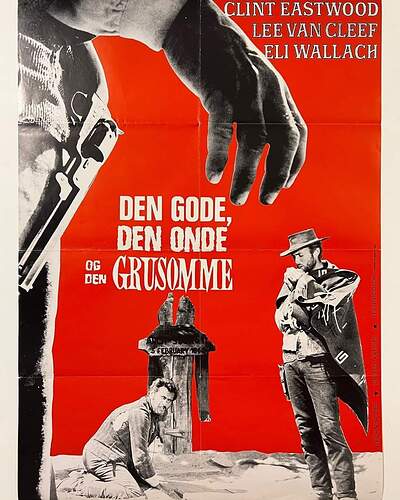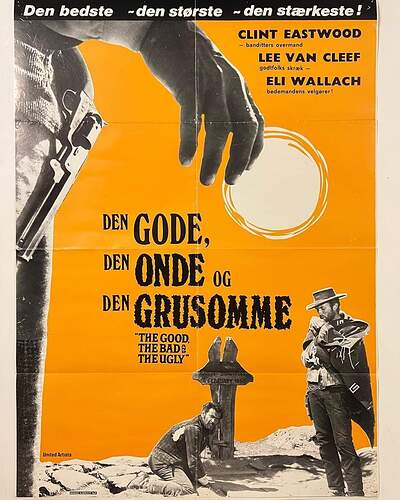If you’re referring to the Italian version, yes, but I think most people are asking about the extended vs the US theatrical version.
The grotto scene was actually never part of any Italian version, but it was presented to the censorship committee together with a shortened version to get a 14 rating. But still was not included in that re-release. Intended re-release most likely, this shorter version was maybe never released according to this :
Of course, but I view it still as the Italian version, despite the including of the grotto scene. Apart from that, in fact the original Italian version remains so far unreleased on DVD or Blu. A mess, but only a small one.
Was this at the Scala King’s Cross by any chance? I saw it twice there - once as part of a Clint Eastwood all-nighter, and the second time might have been in a double-bill with Django when that got its belated UK release.
I also saw the 161-minute version at the NFT (as was), introduced by Quentin Tarantino, and the BFI rep said that the print they were originally going to show was in such poor condition (presumably the 148-minute one) that they borrowed the longer print from ITV, which was using it for their broadcasts at the time.
(Tarantino’s opening line was: “What can you say? It’s a religious experience.” Can’t argue with that)
One of the screenings was at University in the early 1980s and I think the other must have been at the Scala as I saw loads of stuff there. Not with Django or an Eastwood all nighter though.
I thought the grotto scene was in the Rome theatrical premiere, but that Leone removed it after that for the widespread releases. Have I been misinformed all this time?
Maybe it was, maybe it wasn’t.
The premiere was on 23.12.66 and at least none of people who watched the film around x-mas remember this scene. Actually so far nobody saw that scene before it appeared on the MGM SE DVD in 2005.
I think if the film was released the next day to all first run theatres, there was hardly the time to cut out that scene.
Rewatched this one today. It might be my last rewatch of this film for a very long time. I did enjoy the film, but it’s far from being a favorite, and I do not believe it belongs to the spaghetti western genre stylistically. The whole desert adventure war film concept is something I just don’t really find that appealing when compared to a spaghetti western. The film still has western parts, but those are few and far between beyond the first 40 minutes of the film or so. Perhaps a hybrid would be the best way to describe this film, but definitely more of an adventure war film than a spaghetti western. This may also explain why it is appeals to such a wide audience and to people who aren’t spaghetti western fans.
The film is masterfully executed, don’t get me wrong, and it was way ahead of it’s time, but I just don’t like the film that much on a conceptual level. Tuco, who is essential the main character, also feels out of place in a spaghetti western. He is very talkative and emotional, the opposite of Eastwood and Cleef’s mysterious stoic characters. Which is the whole point, but I don’t like it.
I share a similar opinion but still rate it as a 9/10 good for 7th place on my SW Top list for the overall splendid execution.
For me Tuco is slightly annoying and the desert scene too long - but the last several minutes with the extraordinary beautiful Ecstasy of Gold - Morricone theme etc are irresistible ![]()
What is that though? Most would agree that Leone set the template with the Dollars films and while The GBU might be more “busy” with its subplots, it’s very much a spaghetti western.
That’s making an assumption that spaghetti westerns have to stick to a very narrow formula. But he isn’t the only one. Fernando Sancho is almost always talky and overly emotional in his films. You might say that it’s the standard for stereotypical Mexican characters in spaghettis, so how is Eli out of place?
As I said, it’s more of a desert adventure/war film than a spaghetti western.
Most would agree that Leone set the template with the Dollars films
Eh, GBU was not as influential to the SW genre as FFDM and FOD were. What other spaghetti western is a civil war adventure film? Kill Them All and Come Back Alone aside, I can’t think of one. It did influence The Mercenary but I’d argue that that film is more of a war film as well. I think a distinction should be made between a western set in a conflict like “The Wild Bunch” or “Vengeance is Mine” and a hybrid between a war film and a western like GBU or The Mercenary.
That’s making an assumption that spaghetti westerns have to stick to a very narrow formula. But he isn’t the only one. Fernando Sancho is almost always talky and overly emotional in his films. You might say that it’s the standard for stereotypical Mexican characters in spaghettis, so how is Eli out of place?
I guess it’s because he’s a main character? Idk, I just did not like him all that much. I like some of Sancho’s characters though. I also loved volonte’s character in FFDM, who was very emotional. I think it’s just not my preferred type of character for a SW protagonist rather than a dislike of emotional characters.
The only actor who didn’t portray ‘Mexicans’ as the talkative, emotional etc Fernando Sancho/Tuco stereotype was Gilbert Roland - the one genuine Mexican in the Italian West.
Neither GBU nor The Mercenary are for me hybrids between war and western.
They contain some war film elements, but they are at first westerns, the western elements dominate, especially for the style.
It’s the other way round, if you ask me. They are more war films than they are spaghetti westerns.
I can understand that people have problems with a film set in the Mexican revolution, which is a time span way beyond the usual time a western is set in, but in the 60s many westerns took place in these years, but they were not the first. For me the directing and the story telling decides.
From that point of view Villa Rides (1933), Viva Zapata (1953) or Taste of Violence are no westerns.
But Bandido (1956), The Mercenary or Giu la testa are westerns. The last 2 are so much dominated by its style that there is no doubt about it, even if giu la testa could as well be views as a war film. But The Mercenary or Companeros not for a second.
And even Quien Sabe!, despite that Damiani claims the opposite, is too much directed like a western.
GBU is treasure hunt western set against a war background, but it remains a background. The basic plot could easily have been told without all or at least the most of the civil war stuff, and it would have worked as well.
What makes GBU so great is the western stuff, not the civil war stuff. Even if the way Leone uses the civil war makes it different to most of the other SWs. But many SWs were set against a civil war background, and GBU was not the first.
…and the movie would have been 1 hour long… it’s definitely not just in the background, it’s an anti-war film where war themes are given equal importance, if not greater importance to the searching for gold plot. GBU starts and ends like a western, but what’s in between is another story.
And even Quien Sabe!, despite that Damiani claims the opposite, is too much directed like a western.
Eh, not really. ABFTG is fundamentally an espionage film… and it’s my favorite “Zapata western” by far for that reason.
I think there’s something to be said about “western” becoming too broad of a term. I think it was used more for convenience rather than categorization. The spaghetti western being a perfect example, it is a very different genre from the American western. They are polar opposites in a lot of ways, yet they both share the western title. I don’t think that’s necessarily a problem, and I still call GBU a spaghetti western out of convenience, but I think it is stylistically very different from a typical spaghetti western, which was my point. I have no interest in starting a debate on semantics.
A noisy mexican and a stoic gringo as the two lead characters/partners became a recurring theme in spaghettis.
Chunco and Nino in ABFTG, Paco and the Polak in TM, Vasco and Yodlaf in VMC, Juan and John in DYS, etc.
Everything connected with the war could have been replaced with something similar. Without too much problems, even the prison camp could have become a normal chain gang prison. It’s not difficult for me to imagine such ideas.
So it could still have become a 3 hour film, by just changing the background.
I think there’s something to be said about “western” becoming too broad of a term. I think it was used more for convenience rather than categorization. The spaghetti western being a perfect example, it is a very different genre from the American western. They are polar opposites in a lot of ways, yet they both share the western title. I don’t think that’s necessarily a problem, and I still call GBU a spaghetti western out of convenience, but I think it is stylistically very different from a typical spaghetti western, which was my point. I have no interest in starting a debate on semantics.
I disagree with that also completely.
The usual SW is in several aspects different from most US westerns, but still Spags are far away from being an opposite. They are not even anti-westerns, they are basically another possibility for the genre to generate a fresh view on form and/or content.
I have no idea why the style of GBU should be not that of a SW when every single shot is directed like a typical one. Even more, the film’s style is that of the archetypical Spag in perfection. The Mercenary is of a similar virtuosity in western directing.
And what a western is and what not, for that many definitions exist, some are broad, some are close, it’s just another matter of opinions.

